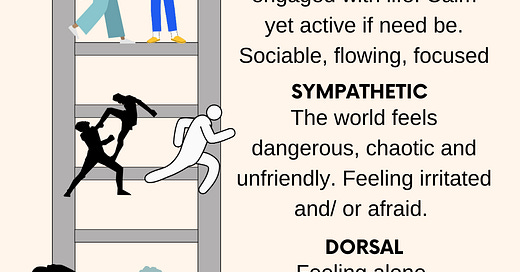Intro to the Autonomic Hierarchy (Supplementary Post)
The 5 Experiential States and their System
The Autonomic Nervous System
The vagus operates within the autonomic nervous system, which regulates our automatic processes such as our heartbeat and digestion. The autonomic nervous system is known as the center of our daily experience because it affects how we eat, sleep, think, speak, work and socialize. It runs on “autopilot” using pre-programmed settings.
The Autonomic Hierarchy
The autonomic nervous system is built with three basic pathways of response. Ventral, sympathetic, and dorsal. We shift between these pathways in a predictable order called the autonomic hierarchy. Each pathway brings its own experiential state: a set of thoughts, emotions, behaviors and bodily functions.
At the top of the hierarchy is ventral, a place of wellbeing and regulation where we are ready to engage.
In intense moments that overwhelm us, we move down the hierarchy into sympathetic, the place of fight and flight.
When fight or flight doesn't help, we drop into dorsal, the bottom of the hierarchy, and collapse.
We regularly travel up and down this hierarchy as we navigate the multifaceted experience of daily life.
Keep reading with a 7-day free trial
Subscribe to WANDERING AROUND VAGUS to keep reading this post and get 7 days of free access to the full post archives.



